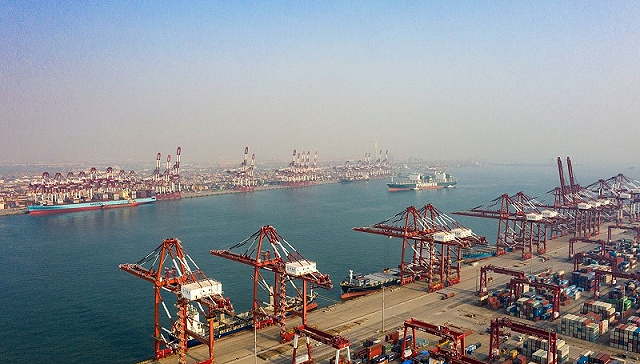The following is a summary of Professor Yu Miaojie’s interview with Jiemian.com. Professor Yu currently serves as Deputy to the National People’s Congress, a member of the Standing Committee of Liaoning Provincial People's Congress, Deputy Secretary of the Party Committee, and President of Liaoning University.
Prof. Yu remains optimistic about China’s trade in 2023, estimating that China's total export and import volume this year may be around 50 trillion yuan—an increase of 8 trillion yuan (or 20% more) than the previous year.

The port operation is currently being carried out in a well-ordered manner at the Qingdao Port Qianwan Container Terminal of the Shandong Pilot Free Trade Zone (February 10, 2023)
According to Jiemian.com’s previous survey, the market generally expects China's foreign trade to initially show a slow trend and then increase later in the year, with its export value down by 3.1% and its import up by 2.6% on a year-to-year basis.
“I am not pessimistic about China's foreign trade this year,” Prof. Yu emphasized in the live broadcast held by the China Macroeconomy Forum. “I even think that this year's foreign trade is optimistic, or discreetly optimistic.” He believes that external demand may be better than expected while, on top of that, China's economic growth remains conducive to the development of foreign trade.
"Europe and the United States were thought to be experiencing rapid economic stagflation not long ago,” Prof. Yu continues. “But the situation currently seems not so bad. It is difficult to talk about the European Union due to the Russia-Ukraine conflict, but looking in the dollar area, its economy has turned for the better this year. Thus, what needs to be questioned is whether the weakness of external demand is a real problem. or not”.
From a domestic perspective, Prof. Yu believes that after the adjustment of Covid-19's epidemic prevention and control policy, the engines of China's supply have fully started. “Compared to 2021,” he asserts, “our exports profits were able to increase by two trillion yuan despite the difficult circumstances of 2022. In my judgment, it is no question that we will increase profits by four trillion yuan this year compared to last year.”
Prof. Yu anticipates that China's total export and import volume this year can be close to 50 trillion yuan, with export being about 28 trillion yuan, import 22 trillion yuan, and trade surplus standing at 6 trillion yuan. According to the customs data, China's total export and import volume in 2022 came to 42 trillion yuan, including 24 trillion yuan for export and 18 trillion yuan for import.
Prof. Yu also predicts that China's trade with countries and regions along the Belt and Road Initiative will take on a steadily approximate one-third proportion this year and moreover throughout the entire “14th Five Year Plan” period (2021-2025). China’s total export and import value with the countries and regions along the Belt and Road Initiative accounts for 32.9% of the total foreign trade value in 2022, up 3.2% from the previous year.
During the interview, Prof. Yu put forward six suggestions for the development of the foreign trade industry. First, export destinations should be diversified, not only targeting mature markets in Europe and the United States, but also targeting emerging industrial countries. Enterprises should make an early business layout and conduct research in a timely manner, with government departments introducing relevant supportive facilities so as to help enterprises achieve diversification of their export destinations.
Second, Prof Yu. suggests resolutely expanding imports, continuing to reduce tariffs, abolishing non-tariff barriers, and reducing trade costs, as well as expanding the import of core components and high-quality intermediate products while accelerating technological progress.
Third, continues Prof. Yu, we should promote the export of service trade through domestic tourism. He points out how China, despite being rich in tourism resources, still has huge room for future development in this area. “To give a basic example,” adds Prof. Yu, “foreign tourists feel very inconvenient when travelling in China due to the lack of public English signs in scenic spots, so it is necessary to improve service awareness and upgrade service levels while continuing effective Covid-19 control.”.
Fourth, within the Belt and Road Initiative trade, Prof. Yu asserts how the focus of the land-based Silk Road should be to develop eastward, strengthening in-depth cooperation with Russia and South Korea, whereas the focus of the maritime Silk Road should be to develop northward, that is, to build a China-Japan-ROK free trade zone.
Fifth, Prof. Yu advises that, when deeply rooting themselves first in Asia and Africa, and then in Latin America, enterprises should be encouraged to take more social responsibilities in foreign destination markets in order to achieve mutual understanding between the enterprises and the locals.
Finally, says Prof. Yu, we should actively promote the establishment of the China-Japan-ROK Free Trade Zone. In the short term, it is difficult for China to join the Trans-Pacific Partnership Agreement (CPTTP), because it needs the unanimous consent of its 11 member states. A free trade zone would offer an alternate solution for China, especially in its relationship with Japan.
“At present, there is no direct economic and trade agreement between China and Japan,” asserts Prof. Yu. “If a China-Japan-ROK free trade agreement can be established without the CPTPP, it will greatly promote China's economic development.” He notes that although Japan is a member of the Regional Comprehensive Economic Partnership Agreement (RCEP), the China-Japan-ROK Free Trade Zone Agreement would be a more advanced and openly cooperative arrangement.
